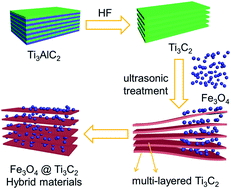Fe3O4@Ti3C2 MXene hybrids with ultrahigh volumetric capacity as an anode material for lithium-ion batteries†
Abstract
The volumetric capacity of lithium-ion batteries is becoming an increasingly important parameter restricting their practical applications in limited space, such as in portable electronic products and electric vehicles. Therefore, novel electrode materials with high volumetric capacities are urgently desirable. Aiming to pursue such kind of electrode materials, a new Fe3O4@Ti3C2 MXene hybrid is fabricated through a simple ultrasonication of Ti3C2 MXene and Fe3O4 nanoparticles. Multi-layered Ti3C2 MXene in the prepared hybrids acts as a superior host to load Fe3O4 nanoparticles due to its open two dimensional structure, favorable electrical conductivity and low Li+ diffusion barrier. X-ray diffraction and scanning electron microscopy analysis show that the Ti3C2 MXene could be homogeneously covered by Fe3O4 nanoparticles at a mass ratio of 5 : 2. As an anode material, the Fe3O4@Ti3C2-2:5 hybrid exhibits high reversible capacities of 747.4 mA h g−1 at 1C after 1000 cycles and 278.3 mA h g−1 at 5C after 800 cycles, which indicate its long cycle lifetime and excellent stability. More importantly, the hybrid material possesses an outstanding volumetric capacity up to 2038 mA h cm−3 at 1C due to the high compact density of the electrode of the prepared hybrid. This study provides further insight into the application of transition metal oxides@MXene hybrids as high volumetric performance anode electrodes for lithium-ion batteries.



 Please wait while we load your content...
Please wait while we load your content...